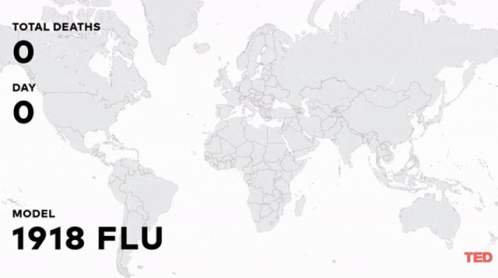Spanish Flu vs Covid-19
by Kenneth Lyen



INTRODUCTION
The new type of coronavirus, SARS-CoV-2 (Covid-19), is sweeping around the world, causing medical and economic chaos. Just over 100 years ago, another pandemic, the Spanish Flu, caused even greater upheaval worldwide. While there are many differences, there are some uncanny similarities. I will try to capture some of these resemblances, using pictures and photographs whenever I can find comparable images.
In both pandemics, the world was largely unprepared to deal with the scale of the problem. The number of people infected was colossal, and the hospitals were unable to cope with the sudden surge in critically ill patients. The mortality was significant, and handling the large number of dead bodies was problematic. Restriction in travel, closure of factories, restaurants, entertainment and other businesses caused economic chaos. The 1918 flu had lasting geopolitical influences, and it appears that Covid-19 will also make its mark on our future.

1918 SPANISH FLU 2019 COVID-19
First detection: March 1918 December 2019
Global cases: 500 million Over 4 million and counting
Incubation Period: 2 to 7 days 5 to 6 days (range 2 to 14 days)



1918 SPANISH FLU 2019 COVID-19
Global Deaths: Over 50 million Over 293,000 and counting
Death Rate: 1% 1 - 3%
Age Specific Mortality: Infants and Young People Young Adults and Elderly
Transmission: Spread through respiratory droplets Respiratory droplets along with feces
and other bodily secretions
Most affected groups: Healthy adults ages 20-40 Adults over 65 with underlying health conditions;
children (2.4% of cases) seem to be spared and are experiencing milder symptoms
Treatments available: None None; supportive care, paracetamol for fever; respiratory support; antibiotics for secondary bacterial pneumonia, and antivirals are administered to help with recovery










Vaccines available: None Currently being developed
End of pandemic: Summer 1919 Not known
Animal Origin: Birds, Swine Bats, Pangolins
WHAT LESSONS CAN WE DRAW FROM THE 1918 SPANISH FLU?
There have been many parallels between the 1918 Spanish Flu and Covid-19. Both caught the world unprepared, spreading rapidly to infect millions and killing humongous numbers of people. Neither infection had any effective medicines to eradicate the virus, and at the height of the pandemic, no vaccines were available. Social distancing, wearing of masks, and good hygiene practices were recommended for both. The effects on the economy was distressing for both pandemics.
There is one observation that we should take note of. Namely, in the 1918 Spanish Flu, many countries thought the flu was over, and people started to gather together in crowds, and some even to celebrate. Unfortunately they celebrated too soon. The falling rates of infection gave one a false sense of security, but the virus was hiding in some people, waiting to rear its ugly head. And indeed, it led to a second wave of the Spanish Flu, which actually infected and killed far more people than the first wave. Therefore, with Covid-19, we should be a bit more careful, and keep a lookout for potential hidden cases or carriers, which can spark a second wave of the current pandemic.
The problem is knowing when to relax or lift restrictive "circuit breaker" or lockdown measures. If the timing is too soon, then it allows excessive freedom of movement, enabling hidden carriers to spread the disease. This decision requires a fine balance of judgement, and we can never be sure if we have timed it right. If we relax these constraints to early, and a second wave of infections erupts, there will always be critics who will blame you: "I told you so!" Hindsight, as they say, is 20/20.
CONCLUSIONS:
Covid-19, the new type of coronavirus illness, is not the first life-threatening disease causing a global pandemic, nor will it be the last. Several learning points have arisen from these devastating pandemics. One cannot hide the disease, so transparency and openness are essential. Anticipation and preparedness for such diseases are mandatory if we are to prevent future catastrophes. The splintering of different countries leads to distrust and delay in the distribution of information. Technical innovations in the diagnosis and treatment of the diseases should be freely shared. The disease has brought out the worst and the best in us. We have people not taking the infection seriously, but we have also seen selfless caring and sacrifices made by total strangers to the sick and dying. These altruistic acts will leave a permanent mark on our future. We need to unite to fight this disease.
Together we can overcome!
REFERENCES:
How the Spanish Flu is similar and different from the coronavirus: https://globalnews.ca/news/6707118/coronavirus-spanish-flu-comparison/
What 1918 Spanish Flu Death Toll Tells Us About COVID-19 Coronavirus Pandemic
https://www.medicinenet.com/script/main/art.asp?articlekey=228841
Why we should stop comparing the Covid-19 coronavirus outbreak to the 1918 Spanish flu
https://www.vox.com/2020/3/9/21164957/covid-19-spanish-flu-mortality-rate-death-rate
Here’s How COVID-19 Compares to Past Outbreaks
Comparing 1918 Spanish Flu with Covid-19
https://www.biospace.com/article/compare-1918-spanish-influenza-pandemic-versus-covid-19/
Spanish Flu Wikipedia: https://en.wikipedia.org/wiki/Spanish_flu
Spanish Flu: https://ourworldindata.org/spanish-flu-largest-influenza-pandemic-in-history
Second wave of Spanish Flu more deadly: https://www.history.com/news/spanish-flu-second-wave-resurgence
Second wave of Spanish Flu killed more: https://www.usatoday.com/story/news/factcheck/2020/04/25/fact-check-total-deaths-each-spanish-flu-wave-unknown/3024648001/
Covid-19 in Singapore: https://kenlyen.wixsite.com/website/covid-19-in-singapore
Written by Kenneth Lyen
Updated 12 April 2020, updated 13 May 2020
%20a.jpg)
